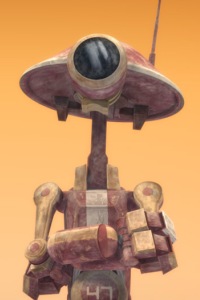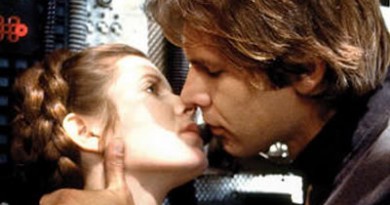The Clone Wars Mid-Season Ends In The Void
 This week’s episode of The Clone Wars, “A Sunny Day in the Void,” was described as “experimental” and “an existential crisis” for the characters. After a less-than-favorable review last week, Megan Crouse says “this is the first droids-plus-concept episode that’s worked for me,” and there were other reviewers who appreciated the episode, too. As always, Megan’s The Clone Wars review is insightful. I found a couple items about the storytelling and Season Five that I wanted to discuss.
This week’s episode of The Clone Wars, “A Sunny Day in the Void,” was described as “experimental” and “an existential crisis” for the characters. After a less-than-favorable review last week, Megan Crouse says “this is the first droids-plus-concept episode that’s worked for me,” and there were other reviewers who appreciated the episode, too. As always, Megan’s The Clone Wars review is insightful. I found a couple items about the storytelling and Season Five that I wanted to discuss.
In my ForceCast Roundtable appearance earlier this year, I noted that the show has been schizophrenic at times. Is it a kids’ show or an adults’ show? And who is it about? What makes me worried for the show’s future is that it still hasn’t decided. While I’ve seen adults praising various episodes across the front half of this season, I’ve also noticed that the show is losing traction with the kids with whom I usually get to chat about it. That’s fine, perhaps, if the creative direction is trending into a more-adult oriented show. But then I can’t help wonder how the tonal note of the last two episodes, and this last one specifically, is supposed to entice those viewers to return after a month-long holiday break.
Whether The Clone Wars is meant to be a kids’ show or an adults’ show, the suicide humor was ill-advised and tasteless. While the showrunners couldn’t have known about this week’s particularly poor timing – including an NFL player committing a murder-suicide and the apparent suicide of a British nurse pranked by Australian radio DJs while she cared for Duchess Kate Middleton in the hospital – that’s all the more reason to avoid this specific topic, especially on a kids’ show, unless it’s truly necessary. In this case, it certainly wasn’t. The jokes at Gascon’s expense just as easily could have invoked symptoms of his dehydration such as passing out or temporary mental unfitness to command. The bumbling commanding officer archetype is an overdone cliché; his suicidal turn didn’t make him any funnier or more endearing.
At times it almost felt like a contest between Gascon and WAC to see who could cause more harm to D-Squad’s ability to successfully complete its mission. The episode relies on character incompetence to drive the plot. It’s only made worse when Gascon and the droids, like Private Pyle and Sergeant Carter, revert back to where they started rather than actually progressing from the lesson they supposedly learned at the end of the previous episode. Assigned as the mission’s pilot, WAC leaves his post to inform Gascon of impending doom. This sort of slapstick bumbling self-sabotage is also one of the not-endearing qualities of Jar Jar Binks, a character whose humor fell flat compared to the likes of Han Solo, Princess Leia, and Yoda in the Original Trilogy; even Threepio, the butt of many of the OT’s jokes, was a foil because of his personality born out of exceptional competence as a protocol droid. “A Sunny Day in the Void” would have been much stronger if it had avoided this lazy way of putting the characters in peril, and instead creatively figured out how to push them to the limits of their skills and abilities.
Finally, the creative parties for The Clone Wars often like to point out that shots, scenes, or episodes are meant to be homages. Fans have been given nods to The Wizard of Oz, Avatar, and any number of other popular and obscure references. This episode seemed more like a pastiche of homages than an actual story. Brent Friedman wrote last season’s Undercover Obi-Wan arc, which used numerous homages effectively without losing sight of the plot and character development for The Clone Wars characters over the four episodes. By contrast, “A Sunny Day in the Void” didn’t really have a story to tell, only a mashup of visuals and ideas from THX-1138, Gomer Pyle – USMC, Jurassic Park, and others combined with a Seinfeld-meets-Star Wars “show about nothing.” I would have liked this episode more if it had connected the homages, and even the existentialist nothingness, back to the basics – the focus on characters and their developmental arcs that make Star Wars work. As the episode closes out the show for the winter, the stakes for the main characters are easily forgettable, not due to a cliffhanger or a mid-season denouement, just obscured by a side trip to the sunless void of Abafar.
On a broader level, over five seasons The Clone Wars has struggled to be a cohesive story that says something. Season Five specifically, while having moments of brilliance like the Young Jedi arc, still hasn’t shown that there is a point to everything. I’d like to see The Clone Wars stop trying to tip its hat to everyone else and actually be a story worthy of hat-tipping.
- Hyperspace Theories: Bad Luck Ghorman - June 2, 2025
- Hyperspace Theories: One Year Later as ANDOR Kicks Off Season Two - May 15, 2025
- REVIEW: Tales of the Underworld - May 4, 2025









